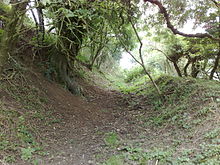Battle of Deorham
| Battle of Deorham | |||||||
|---|---|---|---|---|---|---|---|
| Part of the Anglo-Saxon settlement of Britain | |||||||
 Earthworks around Hinton Hill, just north of Dyrham, Gloucestershire | |||||||
| |||||||
| Belligerents | |||||||
| West Saxons | Britons | ||||||
| Commanders and leaders | |||||||
The Battle of Deorham (or Dyrham) is portrayed by the
Evidence

The only evidence for the battle is an entry in the
577: Her Cuþwine ⁊ Ceawlin fuhton wiþ Brettas, ⁊ hie .iii. kyningas ofslogon, Coinmail, ⁊ Condidan, ⁊ Farinmail, in þære stowe þe is gecueden Deorham. ⁊ genamon .iii. ceastro Gleawanceaster, ⁊ Cirenceaster, ⁊ Baþanceaster.[2]
577: Here Cuthwine and Ceawlin fought against the Britons, and they killed 3 kings, Coinmail, Condidan and Farinmail, in the place which is called Deorham, and took 3 cities: Gloucester and Cirencester and Bath[3]
Scholars agree that the place-name Deorham here survives in the name of
Historiography
Nineteenth-century narrative of Anglo-Saxon settlement
In an influential lecture of 1849 on "The Early English Settlements in South Britain",
Twentieth-century military-history speculation
The belief that the Chronicle account was substantially reliable—notwithstanding its obvious brevity—encouraged elaborate speculation by antiquarians such as
The military historian Lieutenant-Colonel
Re-evaluation
By the early 1980s, a new wave of source-criticism was underway regarding the fifth-to-seventh centuries in Britain, and the Battle of Deorham was prominently tackled by Patrick Sims-Williams.[1] He noted that the Anglo-Saxon Chronicle shows no signs of being a contemporary record for the sixth century and many signs of being a later fabrication based on oral tradition and folk-etymologies of place-names, and that its material for the sixth century may reflect later West-Saxon attempts to legitimise their politics in the seventh, eighth, and/or ninth centuries by circulating stories of an imaginary past.[1]: 26–41 Showing how the Chronicle's 571 Battle of Bedcanford would have functioned to provide a West-Saxon right of conquest to much of the Chiltern Hills and the vale to their north-west following Mercia's conquest of that area in the eighth century, he noted that the Battle of Deorham too might have been used by West Saxons to counter Mercian claims in the Severn Valley.[1]: 33 But he thought more likely the possibility that the annal was based on a Welsh triad, itself unlikely to be historically accurate, arising from a similar tradition to medieval Welsh literature which places an English-battling seventh-century king called Cynddylan in the Wroxeter region.[1]: 33–34
Scholars also argued that the importance given the towns more likely reflects ninth and tenth-century polities, of the time the Chronicle was given its present form, than the de-urbanised sixth century.[9][10]
In popular culture
- The Battle of Deorham and its aftermath features in the early chapters of Rosemary Sutcliff's historical novel Dawn Wind.
References
- ^ JSTOR 44510771..
- ^ "Manuscript A: The Parker Chronicle", in The Anglo-Saxon Chronicle: An Electronic Edition, ed. by Tony Jebson.
- ^ Swanton, M. (1996). The Anglo-Saxon Chronicles. London: Phoenix. p. 18.
- ISBN 0 297 17601 3.
- ^ H. P. R. Finberg, The Formation of England, 550–1042 (London: Hart-Davis, MacGibbon, 1974), pp. 22–23.
- ISBN 0 19 821719 6.
- ^ The Modern Antiquarian
- ^ Alfred H. Burne, More Battlefields of England (London: Methuen, 1952).
- ^ Wacher, John (1995). The Towns of Roman Britain. London: Batsford..
- ^ Simon T. Loseby, "Power and towns in Late Roman Britain and early Anglo-Saxon England" in Gisela Ripoll and Josep M. Gurt, eds., Sedes regiae (ann. 400–800), (Barcelona, 2000), esp. pp 329f (on-line text).
